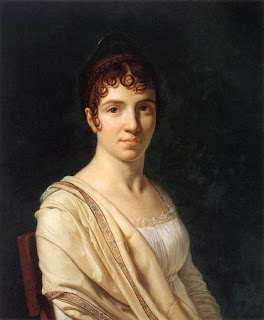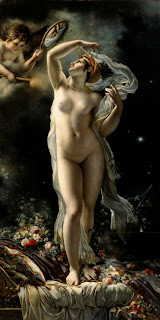The Sleep of Endymion 1791 (Musée du Louvre, Paris)
Anne-Louis Girodet-Trioson
(b Montargis, Loiret, 29 Jan 1767; d Paris, 9 Dec 1824).
French painter.
A French neoclassical painter of portraits, historical, religious and mythological scenes, Born into the bourgeoisie, he became a painter against his parents' objections. Girodet was named ‘de Roussy’ after a forest near the family home, Château du Verger, Montargis. He took the name Trioson in 1806, when he was adopted by Dr Benoît-François Trioson (d 1815), his tutor and guardian and almost certainly his natural father. Girodet took lessons with a local drawing-master in 1773 and by 1780 was studying architecture in Paris, where he became a pupil of the visionary Neo-classical architect Etienne-Louis Boullée. Boullée persuaded Girodet to study painting under Jacques-Louis David, and Girodet joined David’s atelier in late 1783 or early 1784. Of all David's students, Girodet was the most gifted and the most erudite. He was also the most rebellious and competitive. He belonged to the highly successful first generation of David’s school, which included Jean-Germain Drouais, François-Xavier Fabre, François Gérard, Antoine-Jean Gros and Jean-Baptiste-Joseph Wicar.
David’s pupils showed great stylistic uniformity, based on a close emulation of his elevated Neo-classicism, and Girodet’s early compositions are distinguishable from those of his contemporaries only by their slight quirkiness and excessive attention to detail.He quickly grasped the intellectual and stylistic tenets of neoclassicism, but soon set out to violate those very principles in his quest for fame and originality. In his attempt to forge a new aesthetic sensibility, the homoerotic, the effeminate, and the androgynous played significant roles. These experiments can be seen in his most famous work, The Sleep of Endymion (Musée du Louvre, Paris), painted in Italy in 1791 and exhibited in Paris in 1793. Throughout his long career, Girodet chose to concentrate on subjects that confused and conflated masculine and feminine characteristics. In his turbulent and exotic Revolt at Cairo (1810, Versailles), which attests to his interest in Orientalism, a charged homoerotic energy emerges from a physical and emotional contrast between men of different races and psychological dispositions. Although the artist's sexual orientation cannot be determined with certainty, he was widely rumored to engage in homosexual affairs. It may well be that his relationship with another painter, Jean-Pierre Péquignot, who died in 1807, was the most meaningful of his life.
The Sleep of Endymion highlights androgyny as a visual theme and provokes an erotic response from the viewer to the nude male body. The image exploits feminine characteristics such as the delicate ringlets of hair that suggestively fall about Endymion's shoulders. These curls are complemented by the overall elongation of form and the waxen quality of the flesh. The taut, rigid angularity of David's male figures is gone, replaced by a passive and indolent reclining figure whose pose is typically associated with the female nude.
The protagonist of the scene is the shepherd boy Endymion, a mortal, asleep in a hidden alcove located atop the mythical Mount Latmos. He was carried here by the moon goddess, Selene, who, appearing in the painting in the guise of moonbeams, shines through the parted foliage held by a smiling overgrown hybrid figure of Cupid (the boy-god of love) and Zephyr (the personification of the West Wind). She shines upon Endymion, caressing, penetrating, and inhabiting his supple body as he sleeps. The painting is a successful realization of timeless and dreamy erotic desire.
Endymion the shepherd, a man of ideal beauty, is being visited at night by the goddess Diana in the form of a moonbeam. Her passage through the foliage is facilitated by Zephyr.
Sleeping beauty
The shepherd Endymion, the most beautful mortal according to mythology, is sleeping naked beneath a plane tree. Juno, whom he had offended, put him to sleep for thirty years, during which he retained his youthfulness. The chaste Diana has succumbed to his perfect beauty and visits him nightly. The goddess, who is associated with the moon, manifests herself here in the form of a moonbeam, which caresses Endymion's face and torso. Zephyr facilitates the Moon's passage by pulling back the branches of a laurel tree. Revolt in Cairo (on) 21 October 1798, circa 1810
The Entombment of Atala 1808
Chactas the Indian and Father Aubry are burying Atala, heroine of Chateaubriand's novel, published in 1801. Everything about this funerary elogy - the Christian subject, the exotic setting, intense emotions - must have appealed to those who, on the fringes of David's rigor, remained attached to the sacred, to nature and sentiment.
Hermafrodite
Bacchus
Sans culottes El del gorro frigio por Anne Louis Girodet
la mort de hyacinthe
l'entrainement d'Achille
"Galatea (A Study for the Head of Galatea)"
"Portrait of a Young man, half-length seated, in a White Shirt and Brown Coat"
Mademoiselle Lange as Danaë, 1799
Portrait of a young man
Charles-Melchior Arthus, Marquis de Bonchamps
Jacques Cathelineau
Pieta 1789
Portrait of a Woman in Turban. c. 1820
Portrait of Jean-Baptiste Belley, Deputy of Santo Domingo to Convention of France. 1797.
Carlo Maria Bonaparte (a.k.a Charles-Marie Bonaparte), father of Napoleon Bonaparte, 1806
Hippocrates Refusing the Gifts of Artaxerxes I 1792
Hippocrates Refusing the Gifts of Artaxerxes,
The Death of Tatius
Mars et la Renommée, Château de Compiègne
Le départ du guerrier, Château de Compiègne
Le combat, Château de Compiègne
Le retour du guerrier,Château de Compiègne
L’aurore ou étoile du matin,plafond de la chambre à coucher de l’impératrice,Château de Compiègne.
Pygmalion et Galatée.
Minerve entre Apollon et Mercure.
L'été, 1800-1802
L’automne, Château de Compiègne
L'hiver, 1800-1802
Le printemps, 1800-1802
Etude d'une tête de Mameluck. (c. 1810).
Portrait d'homme en chasseur
Self portrait
The Sleep of Endymion. Sketch
Napoléon
Portrait d’Antoine Girodet du Verger, frère de l’artiste
François-René de Chateaubriand
Jeune enfant regardant des figures dans un livre. Premier portrait de Benoît-Agnès, fils du Dr Trioson. Beau et fin. (dit Romainville Trioson) (Salon de 1798)
Girl with a doll
Portrait de Colette Reiset (vers 1824)
Galatea and Cupid, 1813
Lamentation sur la mort de Pallas
The Meeting of Orestes and Hermione,ca. 1800
Portrait of a woman
Portrait of Jacques-Joseph de Cathelineau
Mademoiselle Lange as Venus
Amazone
Le docteur Trioson donnant une leçon de géographie à son fils (1803). Mort en 1804.
Psyche asleep, 1807
Portrait of a Young Man
Benoit-Agnes Trioson
Hortense de Beauharnais
Self portrait
Joseph reconnu par ses Frères "Joseph Recognized by his Brothers"























.jpg)

























































Bravo pour votre blog, très intéressant et bien documenté. je connais la plupart des oeuvres que vous présentez...
ReplyDeleteYour blog is very intersting. Many beautiful documents. You can go and see my own blog.
Je vous propose d'aller sur mon blog :
http://notesdemusees.blogspot.fr/search/label/MONTARGIS
Regards
Hi Jean-Louis Gautreau thanks for your comment. i love your site.
ReplyDelete